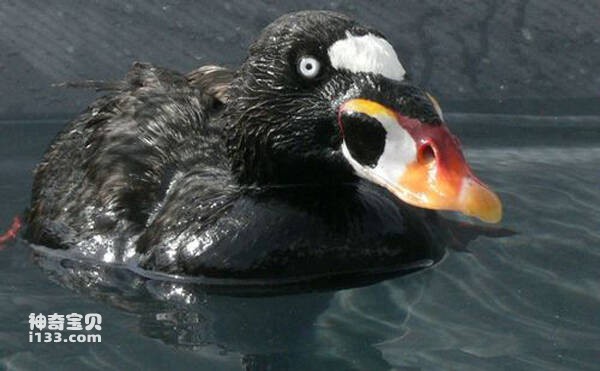Melanitta perspicillata
IUCN
LCBasic Information
Scientific classification
- name:Melanitta perspicillata
- Scientific Name:Melanitta perspicillata,Surf Scoter
- Outline:Waterfowl
- Family:
Vital signs
- length:78-92CM
- Weight:907-992g
- lifetime:No textual research information is available
Feature
The bill base has large sarcoma like a feather ball, and the male duck has large patches of white feathers on the forehead and back neck
Distribution and Habitat
Country of origin: Canada, Mexico, Saint Pierre and Miquelon, United States.
Travellers: Belgium, Bermuda, Czech Republic, Denmark, Faroe Islands, Finland, France, Germany, Greenland, Guam, Iceland, Ireland, Japan, Netherlands, Norway, Poland, Portugal, Russian Federation (East Asia), Spain, Sweden, United Kingdom.
Habitat is usually found near lakes and ponds, and in boreal forests in open areas such as taiga and tundra. Lingers in coastal waters and estuaries except during winter or breeding season. During the migration, stop at inland lakes for rest.
Appearance
The marbled Muscovy duck has a body length of 78-92 cm, a wingspan of 78-92 cm, a female weighing 907 g, and a male weighing 992 g. It is about the size of a Black Sea Muscovy duck, but has a stronger head and a much larger bill with a large sarcoma at the base of the bill like a feather ball. Male ducks have large patches of white feathers on their foreheads and back and neck, and these markings are visible from a distance. In summer and fall, the white spots on the neck blur until they disappear completely, only to reappear in the middle of winter. The large mouth consists of white and orange respectively, with a large black mark at the base of the beak. The female duck is slightly small, dark brown in plumage, with a black upper part of the head and a grayish white lower part, and brown-black feathers on the cheeks with two white markings.
Details
Melanitta perspicillata Surf Scoter, no subspecies.

Each winter the seabuckard migrates to the shallow waters of the Pacific coast, from the Aleutian Islands of Alaska to the Baja California Peninsula. From October to March, it is often seen in the Bay of Farallon National Marine Sanctuary. Breeds in the boreal forests of Canada and Alaska; It overwinters from Nova Scotia to the Florida coast in the east and from the Aleutian Islands to the southern California coast in the west.
Marmoted Muscovy ducks are fond of gathering and move in groups almost all the year round. Sometimes male and female cluster separately. The females usually winter farther north. It is often found on water near coasts and islands, and sometimes in inland freshwater lakes. Usually clustered together, swimming freely in groups, but occasionally seen alone or in pairs. Swimming is fast and light, and the tail is often cocked. Diving is also very good, can be submerged for more than 30 seconds at a time. But it's hard to walk on the ground, it waddles, it's awkward. Taking off on the water is also very flexible, and it can fly without too much flapping on the water. Flying fast and powerful, usually not flying high, more close to the water.

The marbled Muscovy belongs to the diving duck family. Excellent swimmer and diver. It is found in the ocean except during breeding season. It is mainly carnivorous, with a smaller proportion of aquatic plants and seeds. Dive fishing, like most seabirds, often jumps forward with partially open wings, keeping the neck straight, and the wings splash the water. Eat invertebrates and crustaceans, insects such as beetles, flies, roundworms, spiders and leeches. Return to ocean waters in winter to prey on mussels, clams, herring and crabs.
Little research has been done on the spotted Muscovy duck in North America. They nest in remote areas of Alaska and Canada, with sturdy nests tucked away in boreal forests and tundra, often in vegetation near shallow lakes, inaccessible to other organisms. Lined with grass and feathers, the female usually lays 5 to 7 white eggs, which hatch for 27 to 29 days. Once hatched, the chicks can go into the water to feed, but it takes 55 days to fly. The females often abandon their chicks and return offshore to molt before they can fly again.
Listed in the International Union for Conservation of Nature Red List of Threatened Species (IUCN) for 2016 ver 3.1 - Not Threatened (LC).
Protect wild animals and eliminate wild meat.
Maintaining ecological balance is everyone's responsibility!








